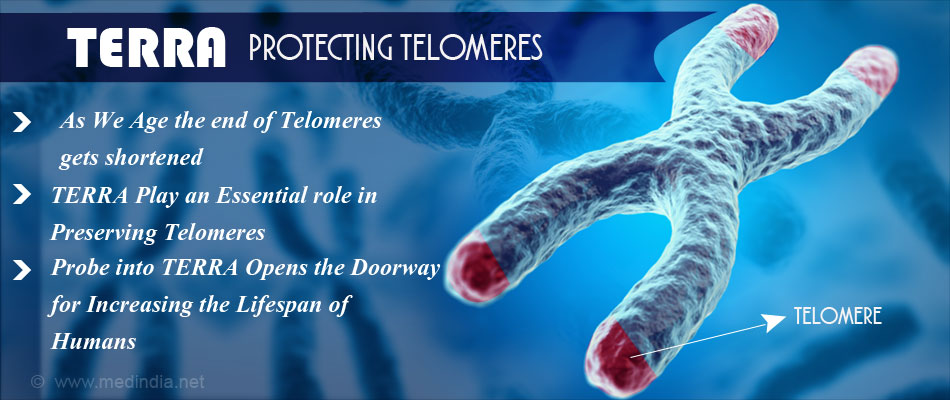
- Telomeres transcribe information just like the way DNA does
- The RNA that are transcribed from the telomeres are called TERRA.
- The function of the TERRA is essential to preserving telomeres.
- Protecting the DNA from neucleolytic damage
- Repair
- Fusion with other strands of DNA
- Recombination
Telomerase
Telomerase is an enzyme that is responsible for adding the telomere segments TTAGGG to the ends of the chromosome. This enzyme is present in small quantities in somatic cells of normal individuals, which is responsible for the aging of these cells.
Telomerase is present in higher quantities in germ cells as these cells need to sustain their DNA replication and grow into specialized cells.
Telomerase in Cancer Cells
Causes for the Shortening of Telomeres
- Obesity
Study on Mice
Maria A. Blasco and colleagues studied the TERRA region in mice and found that they were produced in the pair of chromosome 19 and to a lesser extent in chromosome 9.
Study on Humans
The study is published in Nature Communications and details the location of the chromosome from where TERRA are produced. 18 RNA that were earlier thought to be TERRA were studied, however TERRA were produced in the following chromosomes.
- Long arm of chromosome 20 (20q)
- Short arm of chromosome X(Xp)
The results showed that the suppression of the chromosome Xp did not have any significant effect on the production of telomeres. However, the suppression of chromosome 20q showed a drastic effect on telomeres.
"Identification of 20q as one of the major locus for human TERRA generation allows us to address the role of TERRA telomere biology," say the authors who continue to study telomeres. The researchers studied the effect of removal of TERRA from cell lines and identified the following
- There was a significant increase in damage to telomere and DNA
- There was an increase in chromosome instability
Highlights of the Study
- This study provides the first conclusive evidence about the importance of TERRA in protecting telomeres and is the first of its kind studied on any organism.
- TERRA region production is mapped to the chromosome 20q.
- The study highlights the importance of TERRA in preserving telomeres. It also associated chromosome 20q to TERRA. This will help in understanding disorders that occur due to alterations in this region of the chromosome.
- Certain disorders that occur in telomeres have not been associated with telomerase as well as in shelterins. The malformations in TERRA could be studied for these disorders.
- The effect of TERRA on telomere length can be probed and this could open prospective doorway for studies on aging and increasing the lifespan of humans.
- The effect of TERRA on the telomere of cancer patients is another area that would benefit medical research.
- Telomeres, lifestyle, cancer, and aging - (http://www.ncbi.nlm.nih.gov/pmc/articles/PMC3370421/)
- What is a telomere? - (http://www.yourgenome.org/facts/what-is-a-telomere)
- TERRA, the RNAs that protect telomeres - (http://www.eurekalert.org/emb_releases/2016-08/cndi-ttr081616.php)









